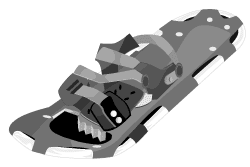Snowshoes
Snowshoes are versatile, but it helps to know the basics of construction, style, and components before you buy.
How To Buy Snowshoes
Snowshoeing is suitable for all ages and fitness levels. Although a few snowshoe models are designed for specific activities and conditions, most come in only a few sizes and are fairly versatile.
Types of snowshoes
All styles of snowshoes will let you travel across the snow without sinking or struggling because they spread your weight evenly across a large, flat surface area. In general, the heavier the person or the lighter and drier the snow, the larger the snowshoe needs to be.
Recreational
- These snowshoes are ideal for walking or hiking on terrain that is not very steep or rugged
Mountaineering
- These snowshoes are more technical in design and they feature more aggressive traction to negotiate the steeper, icier conditions frequently encountered while mountaineering or on long hikes
Aerobic/Running
- These snowshoes are made for cross-training and competitive snowshoeing on packed trails. They are lightweight, durable and maneuverable.
Youth
- These snowshoes are smaller recreational snowshoes that are suitable for total weights not exceeding 125 pounds. Many styles are as durable as adult models, and can also be used by small adults.
Frames and decking
- Most of today's snowshoes have aluminum frames (the outer edge of the snowshoe to which the decking is attached), although frames may also be made of wood or high-tech materials such ascarbon fiber
- Although wooden snowshoes perform well, they require a lot of maintenance and are prone to breakage
- Decking - the flat surface of the snowshoe that allows you to walk on the snow without sinking - used to be made of rawhide, but is now commonly made of synthetic materials such as Hypalon, Quadex,polypropylene or plastic
- These materials are strong, light, good at shedding snow, offer good floatation and require next to no upkeep
Bindings
- Bindings resemble harnesses that attach your boots to your snowshoes
- They usually consist of a platform with nylon straps that go over the foot and around the heel
- Most bindings can accommodate a variety of footwear, from hiking and snowboard boots to technical mountaineering boots
- Some bindings are lighter and fit snugly, such as those made for running, while others are designed to be worn with heavy boots and have ratcheting straps
- Rotating Bindings pivot where they attach to the decking, under the balls of the feet. This allows you to walk easily and climb hills.
- Fixed bindings are connected with rubber or neoprene bands that spring back up with each step, allowing a comfortable stride
Traction devices
Most modern snowshoes feature crampons or cleats that help provide traction and allow you to grip hard-packed, icy and steep terrain. Crampons, or cleats, are toothed traction devices on the undersides of snowshoes. They can be located at the toe, heel or under the ball of the foot.
- Recreational snowshoes generally have moderate traction, usually at the forefoot
- Mountaineering models feature aggressive traction at both forefoot and heel
- Aerobic snowshoes usually have extra cleats at the toes for traction when pushing off
- Toe or instep crampons pivot with your feet and dig in as you walk or climb
- Heel crampons are usually shaped like a V. On a descent, they fill with snow and help slow you down.
- Traction bars provide lateral stability and help reduce side slipping when traversing hills or uneven terrain

How to determine size
- To find the right size snowshoe for your needs, determine what your approximate weight with gear will be. A heavier person, or one with a heavy pack, will require larger snowshoes than a smaller person or one carrying a light load.
- Size is also determined by terrain and snow conditions. You will likely need more floatation in fluffy powder than on wet, packed or icy snow.
- You will probably want more compact snowshoes if you plan to frolic on packed trails or negotiate steep slopes or tight spaces
- Conversely, open areas with large, deep drifts require better floatation and hence larger snowshoes
- As a rule of thumb, get the smallest size that will support your weight for the type of snow and terrain you plan to snowshoe in. Smaller snowshoes are less awkward and easier to deal with.
- Use the information and chart below to help determine the proper snowshoe size:
- Snowshoes usually come in three sizes: 8"x25", 9"x30" and 10"x36"
- Women's-specific models are also on the market, and many come with smaller (8"x21") contoured frames as well as bindings that accommodate women's generally smaller-sized footwear
- Youth models usually come in 6"x15" and 7"x18" sizes
